The Essential Guide to Kitesurfing Life Jackets
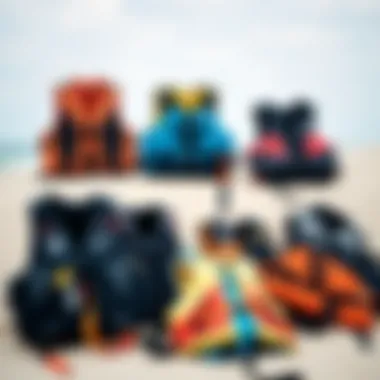
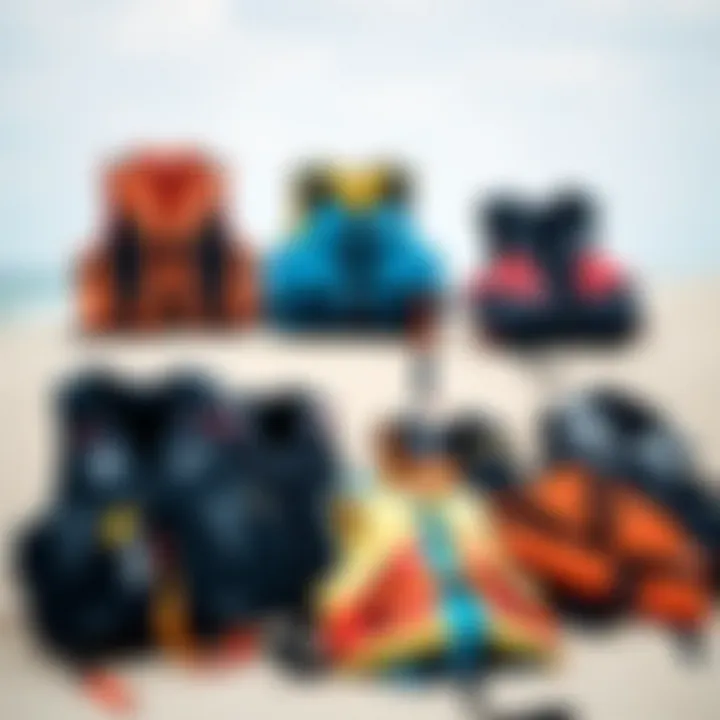
Intro
Kitesurfing, a thrilling blend of surfing and aerial excitement, is not just about carving the waves or performing dizzying tricks. Central to this exhilarating activity is the often overlooked yet critical component: the life jacket. Whether you’re slicing through water like a seasoned pro or just starting to find your footing in the sport, understanding the importance and intricacies of life jackets can make the difference between a fun day out and a dreadful incident.
When individuals embark on their kitesurfing journey, many might perceive a life jacket merely as a cumbersome piece of gear. However, it is much more than that. As you navigate through gusty winds and turbulent waters, having the right flotation device serves not only as a safety net but also enables you to focus fully on the art of kiting.
In this guide, we will look into a few essential aspects of kitesurfing life jackets. We’ll break down the types available, delve into their features and discuss essential safety standards that apply to these lifesaving devices. Through examining real-world regulations and technological innovations, we’ll also provide practical tips to help you select the ideal vest.
Remember, whether you’re an adrenaline junkie pushing the limits or someone who appreciates a leisurely glide over the water, properly equipped kitesurfers tend to have the best experiences. Let’s get started on this essential exploration into kitesurfing life jackets and why they matter, not just for safety but also for enhancing performance on the water.
Gear and Equipment
Navigating the vast waters while kitesurfing requires more than just skill and courage; the right gear plays a vital role in both safety and enjoyment. In this section, we will explore two key categories of equipment: the essential gear for beginners and advanced equipment for seasoned riders.
Essential Kiteboarding Gear for Beginners
As a novice in kitesurfing, the choice of gear can be both exciting and overwhelming. The essentials generally include the following:
- Life Jacket (Personal Flotation Device): This is a must-have. Opt for a jacket designed specifically for kitesurfing. They typically offer mobility while ensuring that you're buoyant.
- Kite: Picking the right kite size is crucial. For beginners, starting with a slightly larger, more stable kite allows for easier control and a gentler introduction to the sport.
- Board: A larger board can be more forgiving for those still finding their balance. It offers better stability, making it the ideal choice for newcomers.
- Bar and Lines: These are essential for controlling your kite. A reliable setup is important to avoid unwanted surprises.
- Harness: Comfortable and secure harnesses distribute the kite's pull across your body, minimizing strain during riding.
- Wetsuit: Depending on the weather, a wetsuit helps keep you warm and can provide extra buoyancy in case of falls.
Advanced Equipment for Experienced Riders
For those who have honed their skills and wish to progress further, advanced equipment can elevate the kitesurfing experience. Here’s what seasoned riders typically consider:
- Performance Life Jackets: Advanced life jackets focus on streamlined designs, allowing for greater freedom of movement while still adhering to safety standards.
- Specialized Kites: Riders might choose competition-grade kites, which are geared for performance, offering faster speeds and quicker responses.
- Custom Boards: Tailored boards that fit the rider’s style and preference can provide a distinct advantage in agility and speed.
- Upgraded Harnesses: Higher-end harnesses offering features like better padding or quick-release mechanisms can enhance comfort and safety during peak performance.
- Technical Accessories: Items like waterproof communication devices to stay in touch, or GPS trackers to monitor performance metrics, may be useful tools for serious riders looking to improve.
Having the right gear sets the stage for a successful kitesurfing experience. Safety should never be compromised, and that starts with making informed choices about the equipment you choose to use.
Foreword to Kitesurfing Safety
Kitesurfing is as exhilarating as it is demanding, drawing many adrenaline junkies into its vibrant waters. However, with the thrill comes a certain degree of risk. This section lays the foundation for understanding safety in kitesurfing, particularly the critical role that life jackets play. This isn’t just about being able to stay afloat; it’s about having the right gear to ensure that safety is prioritized without compromising the fun.
Understanding the Risks
Before diving into the waves, it’s essential to recognize that kitesurfing can be unpredictable. Weather conditions can shift in an instant, turning a calm day at the beach into a challenging situation. Riders often face risks ranging from unexpected gusts of wind to choppy waters that could unseat even the most experienced athlete. Falling from a height after being lofted by the kite is another hazard that can lead to serious injuries. Each outing presents a unique set of challenges, thus understanding these risks is paramount in enjoying the sport safely.
Riders must be aware of their own skill level and limitations, as well as environmental factors that can contribute to potential danger. Adapting to changing weather patterns and being equipped with the right safety gear is no longer optional; it’s a comprehensive approach to responsible kitesurfing. It’s crucial to engage in a culture of safety, where understanding and addressing these risks become part of every rider's routine.
Importance of Personal Flotation Devices
Personal flotation devices, or life jackets, act as a vital component in the kitesurfer’s safety arsenal. The right jacket can mean the difference between a minor mishap and a serious accident. They offer buoyancy, enabling riders to float if they become separated from their board or hang on too long to their harness, preventing exhaustion and promoting survival.
A well- fitted life jacket will not hinder movement, allowing for mobility and comfort while kitesurfing. It is often underestimated, however, that the psychological reassurance provided by wearing a life jacket can enhance a rider's confidence, encouraging them to push their boundaries while also being aware of their safety.
Furthermore, regulations and guidelines across various regions stipulate a requirement for life jackets during kitesurfing. Not adhering to these norms may not only put the rider at risk, but could also result in penalties from regulatory bodies. As such, this protective gear aligns perfectly with thrill-seeking and safety, offering peace of mind whether you're a novice learning the ropes or a seasoned rider cruising along the waves.
"Safety isn’t just a destination; it’s a continuous journey that every kitesurfer needs to embark on."
In summary, kitesurfing safety is a multi-faceted issue that hinges upon understanding the inherent risks involved and recognizing the indispensable role that life jackets play in ensuring a safe and enjoyable experience on the water.
Types of Kitesurfing Life Jackets
Kitesurfing can be exhilarating, but without the right safety equipment, the thrill can quickly turn to trepidation. The type of life jacket you choose can significantly ground your surfing experience, balancing both safety and performance. Different jackets are designed for different styles of riding and conditions. Selecting the appropriate one not only keeps you afloat in turbulent waters but also enhances your overall experience on the water. Thus, understanding these types—what they are, how they differ, and their respective benefits—is vital for every kitesurfer.
Traditional Life Jackets vs. Impact Vests
Traditional life jackets and impact vests serve different purposes but are both essential in their own right.
Traditional life jackets are generally characterized by their inherent buoyancy. They are designed primarily to keep you afloat, even if you’re knocked unconscious. Their high visibility and robust floatation materials ensure that should you take a tumble or face unexpected issues, you’ll remain above water. However, they often can be quite bulky, which can hinder movement, especially when you’re trying to perform tricks or turns during kitesurfing.
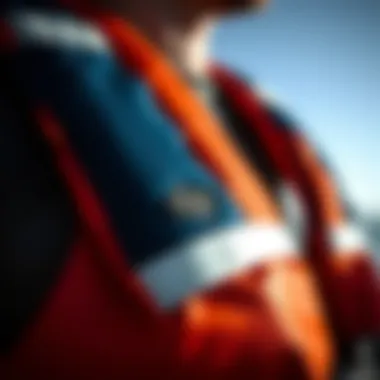
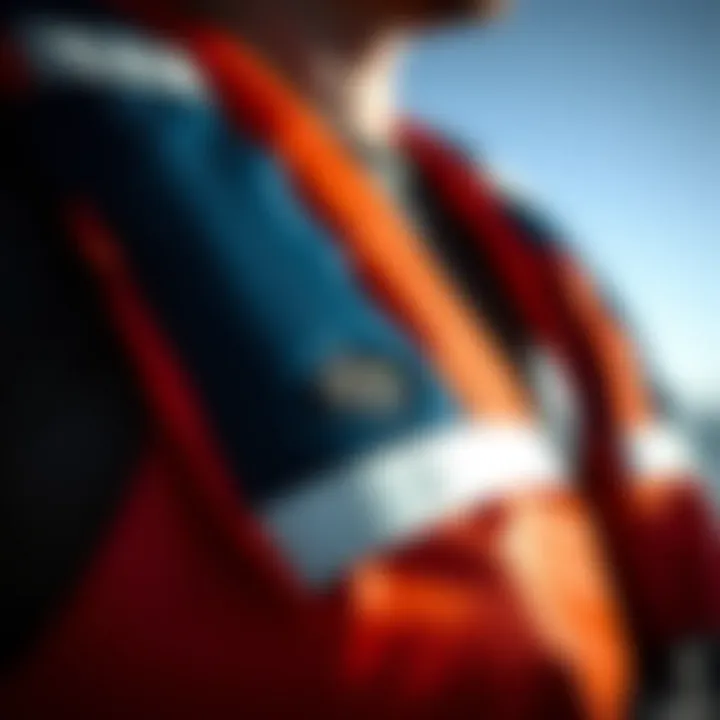
On the other hand, impact vests are a rider’s go-to for kitesurfing. They offer protection against the inevitable splashes and rough impacts that come with high-speed riding. Their slimmer profile is tailored for mobility, allowing for freedom of movement while still keeping you safe. Impact vests may not offer as much buoyancy as traditional life jackets, but riders often bolster their safety with the combination of a buoyancy aid along with an impact vest for comprehensive protection in the water.
Considerations when choosing include:
- Activity type: Traditional for casual boating, impact for kitesurfing.
- Fit and comfort: Ensure a snug yet comfortable fit to avoid chafing.
- Visibility: Bright colors can be crucial in emergency situations.
Automatic Inflatable Jackets
Enter the automatic inflatable jackets, the slickest innovation in life jacket technology. As the name implies, these jackets inflate automatically when submerged in water, providing buoyancy without the bulkiness associated with traditional options. This feature can be a lifesaver; however, it does require careful consideration. Automatic inflation means that there’s reliance on a mechanism, which can sometimes fail or deploy inadvertently.
Benefits of these jackets include:
- Minimal bulk: Great for riders who prefer to stay light on their feet.
- Rapid flotation: Inflates quickly, offering immediate safety.
- Versatile use: Can be utilized for a variety of water sports besides kitesurfing.
However, before committing to one, check that the automatic inflation mechanism is reliable and easy to test prior to water usage. Because these jackets require a bit more maintenance and understanding of their mechanics, they sometimes aren’t a beginner’s choice.
Hybrid Models
In the quest for the perfect equilibrium between buoyancy and functionality, hybrid models have emerged. These life jackets merge the traits of traditional jackets and impact vests, delivering both floatation support and a snug fit for high-speed water sports.
These combinations often enhance comfort without compromising safety, making them an appealing option for kitesurfing enthusiasts who wish to have it all. Hybrid models typically come with:
- Integrated buoyancy: Adequate enough to keep you afloat while still being streamlined.
- Flexibility: Constructed to allow for full range of motion, essential for performing tricks.
- Durable materials: Often designed to withstand harsh environmental conditions.
When selecting a hybrid model, make sure to assess the specific conditions you’ll encounter in the water. Their versatility benefits both casual riders and those who enjoy an adrenaline rush. While they might come at a slightly higher price, the investment can pay off in terms of protection and performance.
"Choosing the right life jacket isn’t just about sticking to standards; it’s about ensuring your personal safety while encountering the great blue."
In summary, understanding the types of kitesurfing life jackets available equips riders with critical information needed to make informed decisions. Each type has its strengths and weaknesses, matching various riding styles and preferences. Ultimately, your safety gear shapes not only your protection but also your enjoyment on the water.
For more detailed insights, visit the International Kiteboarding Association or check safety regulations on U.S. Coast Guard.
Key Features of Kitesurfing Life Jackets
Choosing the right kitesurfing life jacket involves understanding various features that contribute to safety and performance on the water. In the heart of this choice lies the material, fit, and integration with other gear. These elements do not merely serve a functional purpose; they define the quality of the overall kitesurfing experience. When a life jacket functions as a second skin, it elevates both safety and comfort, allowing riders to focus on performance rather than equipment malfunctions.
Flotation Material and Buoyancy
The flotation material used in life jackets determines the buoyancy provided, a critical factor for any kitesurfer. Common materials include closed-cell foam and air-inflatable options. Closed-cell foam jackets offer high buoyancy, while inflatable jackets, though lighter and less cumbersome, require either manual or automatic inflation.
Why It Matters:
- Buoyancy Levels: Jackets must maintain a buoyancy adequate enough to keep the rider above water in case of emergencies. For instance, a jacket with at least 50N of buoyancy is often recommended for kitesurfing.
- Material Durability: The resilience of the material matters. Closed-cell foam, while bulkier, sustains its buoyant qualities longer than some inflatable options, which can deflate over time, especially if not cared for properly.
Selecting a jacket with the proper flotation material ensures that you won't be left high and dry in the water. Riders must consider the balance between light weight and buoyancy based on their personal kitesurfing style and conditions they usually encounter.
Fit and Comfort
A well-fitted life jacket feels like a second skin. It should neither restrict movement nor float away during intense sessions. Ensuring that the jacket conforms to the body shape can significantly influence performance and safety.
Key Considerations:
- Size and Adjustability: Look for jackets that offer adjustable straps or a range of sizes. A snug fit helps maintain close contact with the body for optimal buoyancy.
- Ventilation and Breathability: Many advanced models include mesh panels to enhance airflow. This feature is particularly useful on hot days when kitesurfers are likely to spend extended periods on the water.
In kitesurfing, movements are unavoidable, ranging from jumps to quick turns. A jacket that fits correctly not only enhances comfort but also minimizes bulk, allowing for greater freedom of movement.
Harness Integration
Integrating the life jacket with a harness can foster a seamless kitesurfing experience. Not all jackets are designed to accommodate a harness, making it essential for riders who prioritize style and function.
Benefits:


- Unified Design: Jackets with harness integration allow riders to attach their harness directly to the vest, leading to less slipping and more control.
- Reduced Discomfort: Without proper integration, a poorly fitting jacket might ride up, causing discomfort and potentially leading to safety risks through decreased buoyancy performance.
When selecting a life jacket, it’s crucial to check compatibility with your current harness. The right combination can make all the difference between an enjoyable ride and a frustrating session on the water.
"The right life jacket is more than just safety gear; it's about enhancing your ride and empowering your adventures on the water."
Safety Standards and Regulations
When diving into the realm of kitesurfing, understanding the safety standards and regulations becomes more than just a matter of legality; it’s about preserving life and promoting responsible enjoyment of the sport. Kitesurfing, while exhilarating, comes with inherent risks, and adhering to established safety guidelines ensures that enthusiasts can focus on the thrill of riding the waves without unnecessary worries. Life jackets play a pivotal role in this equation, serving as a vital layer of protection against potential dangers.
Global Standards for Flotation Devices
Globally, several organizations work tirelessly to form a blueprint for safety through standardized regulations. The International Organization for Standardization (ISO) is one such body that outlines requirements for personal flotation devices (PFDs). Their guidelines set expectations on buoyancy, impact resistance, and material durability, all instrumental in determining how effective a life jacket can be in crises.
Moreover, the European Committee for Standardization (CEN) also provides critical benchmarks that must be met for flotation devices sold within European nations. This affects not only manufacturers but also consumers who seek high-quality products that meet these robust standards. The requirements are precise:
- Buoyancy Ratings: Jackets must provide sufficient flotation to keep a person's head above water.
- Impact Resistance: For water sports like kitesurfing, vests should safeguard against impact from falling.
- Durability: Material must withstand the rigors of saltwater and sun exposure without deteriorating.
Such global standards not only assure manufacturers of what they need to achieve but also serve as a reference for buyers looking to make informed choices. When you choose a life jacket that adheres to these guidelines, you’re essentially opting for a product that prioritizes your safety. Remember, a life jacket that fails to meet these criteria may place you in more peril than without one at all.
Regional Regulations
After understanding the global groundwork, one must also consider regional regulations. Countries often tailor safety protocols based on local water conditions, climates, and population habits. Depending on where you are engaging in kitesurfing, local guidelines may dictate the type of life jackets required, as well as other safety measures.
In the United States, for instance, the Coast Guard mandates that all vessels, including those using kitesurfing equipment, carry approved life jackets for each person onboard. However, wearing them is also strongly recommended, especially in states that frequently feature unpredictable weather or waterways notorious for strong currents.
If you're kitesurfing in Europe, you might find that some countries have stricter regulations on PFD usage, emphasizing the necessity of wearing them at all times in certain areas. Crucially, you also have to check whether your age influences these regulations. Many regions enforce specific rules for minors, mandating them to wear a PFD while kitesurfing.
When traveling to kitesurfing destinations, always conduct a quick check on local laws regarding life jackets and personal safety devices. This not only keeps you legally compliant but also enhances your overall safety experience on the water.
"Safety regulations are not obstacles but the pathways to a more enjoyable kitesurfing adventure."
In summary, global standards and regional regulations intertwine to inform personal safety in kitesurfing. As a rider, staying informed about these norms can save lives and elevate the experience out on the water.
Choosing the Right Kitesurfing Life Jacket
Choosing the right life jacket for kitesurfing is not merely about picking the most colorful or the most advertised model on the market. It encompasses several factors essential for ensuring safety, comfort, and performance on the water. Each kitesurfer, whether a novice or a seasoned rider, has unique preferences and needs that shape their choice.
Assessing Individual Needs
Before diving into options available in the market, it is imperative to assess individual needs. This assessment includes factors like body size, skill level, and the type of kitesurfing one engages in. A weightier or taller kitesurfer may require a more robust jacket that provides adequate buoyancy, while a lighter individual might prefer something more streamlined to aid in mobility.
Furthermore, consider your comfort concerning the water conditions you frequently encounter. If you’re often out in choppy waters, you might prefer a vest with higher flotation capabilities. Understanding personal swimskill also plays a role; those who are less confident in the water may lean towards options that provide enhanced buoyancy.
Trial and Error: Finding the Perfect Fit
Once you have assessed your initial needs, the next step is trial and error to ensure that the jacket fits like a glove – or rather, like a well-fitted life jacket. It cannot be stressed enough that the fit of a life jacket is paramount to its performance.
You may want to try on different models in-store or at your local kitesurfing shop, where you might find enthusiasts willing to share their insights. Pay attention to how the jacket feels when you move and perform kitesurfing maneuvers. It shouldn’t ride up or feel constricting; ample freedom of movement is crucial. Test it while simulating your ride—this ensures that when you hit the water, your life jacket behaves as expected.
"A life jacket is only as good as its fit. If it doesn’t sit right, it won’t save your life."
Budget Considerations
Budget is an undeniable factor when choosing a life jacket, but it shouldn’t solely dictate your decision. The market offers an array of options at varying price points; however, it’s vital to balance cost with the necessity of safety features.
While it might be tempting to go for a cheaper model to save a few bucks, investing in quality could pay off in the long run. Consider the construction, materials used, and any advanced features that higher-priced models might offer.
When budgeting, make a list of must-haves versus nice-to-haves in a life jacket—this can guide you toward a model that aligns with your preferences and your wallet. Remember that safety gear is one purchase you do not want to skimp on. Look for those jackets that meet safety certifications, as these tend to have better workmanship and are likely to last longer.
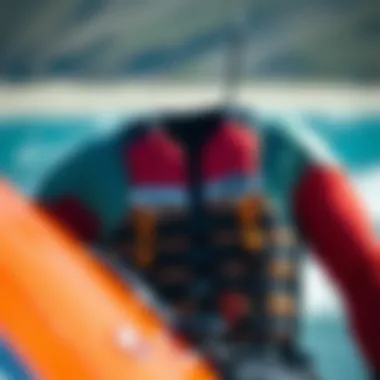
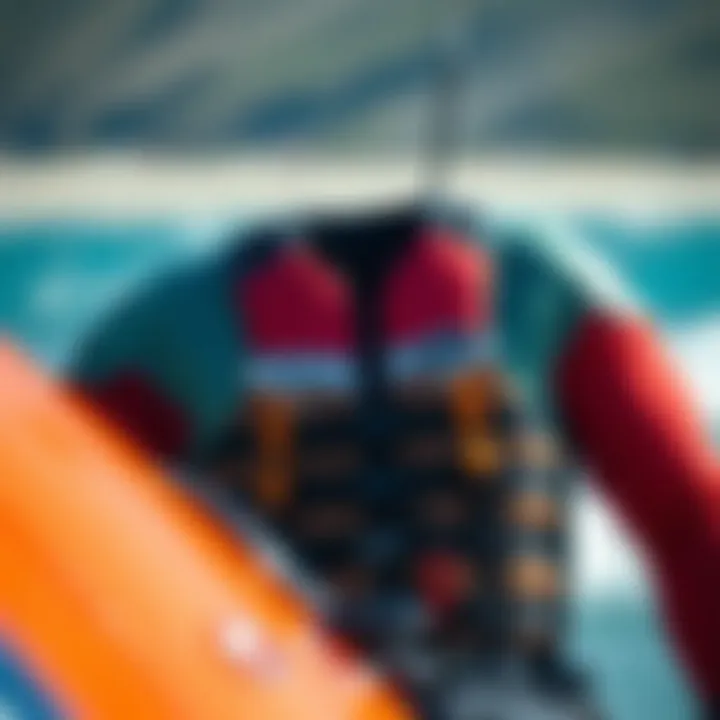
Ultimately, choosing the right kitesurfing life jacket is an integral part of your gear setup. It’s about more than just the ride; it’s about ensuring peace of mind while you chase the waves and the winds.
Technological Innovations in Life Jackets
The realm of kitesurfing safety gear has seen remarkable advancements in recent years, particularly in the design and functionality of life jackets. With the rise of technological innovations, these flotation devices have transformed from basic safety equipment into sophisticated tools that offer enhanced protection and performance for riders. It’s not simply about staying afloat anymore; it’s about the integration of smart technology that provides a multitude of benefits, ensuring a safer and more enjoyable kitesurfing experience.
Smart Life Jackets
At the forefront of life jacket technology are smart life jackets, which incorporate electronic features to monitor and enhance safety. These jackets often include sensors that detect water immersion or sudden changes in body temperature. When activated, they can send alerts to the wearer’s mobile device or directly to emergency services, providing crucial information in case of distress.
Such advancements act like a safety net when engaging in a sport fraught with risks. Imagine being out in choppy waters and suddenly needing assistance; a smart jacket could feasibly save your life by ensuring help is on the way.
Features to consider include:
- GPS Tracking: Helps locate a lost or incapacitated rider swiftly.
- Fall Detection: Automatically calls for help if the wearer is submerged for too long.
- Integrated Communication: Some models allow voice or signal communication via Bluetooth, enhancing rescue operations.
These jackets may come at a higher price, but when considering their potential to prevent incidents and provide timely rescue, their value becomes clear.
Enhanced Visibility Features
Visibility is another critical aspect that modern life jackets are addressing. Kitesurfing can take place in various environments, some of which make it difficult for others to see a rider, especially in low light or choppy settings. Enhanced visibility features often include bright colors and reflective strips, ensuring that those on the water or shore can easily see the kitesurfer.
Features that boost visibility include:
- Neon Color Schemes: Brightly colored jackets improve visibility against the backdrop of the ocean.
- Reflective Material: Strips or patches that reflect light can guide rescuers to the individual.
- Strobe lights: Some jackets come with LED lights that can be activated in emergencies to further increase visibility during twilight or nighttime.
Incorporating enhanced visibility features into life jackets isn’t just a luxury; it can significantly impact safety, making it easier for both fellow riders and rescuers to spot someone in distress.
The safety of kitesurfing riders has benefited immensely from these technological advancements, showcasing how innovation can enhance traditional safety equipment while adapting to changing water and weather conditions.
As the kitesurfing community continues to grow, the importance of adopting these innovative life jackets cannot be underestimated. They are not just an addition to safety gear; they represent a shift in how we perceive and approach safety in high-energy water sports.
Kitesurfing Life Jacket Maintenance
Maintenance of kitesurfing life jackets should never be an afterthought. To ensure safety while gliding through the waves, it's crucial to give proper attention to the care and upkeep of these vital pieces of equipment. A well-maintained life jacket not only enhances your safety but also prolongs the lifespan of the vest, making it a smart investment.
When you're out on the water, confidence comes from knowing your gear is up to par. A neglected life jacket, on the other hand, can become a liability. Regular maintenance is essential for optimal performance, especially since you rely on your jacket to perform when you need it most. This diligence could be the difference between a close call and a serious incident.
Cleaning and Care
Keeping your life jacket clean is the first step in maintenance. Saltwater, sand, and sunscreen can wreak havoc over time, leading to deterioration. Here's how to care for your vest:
- Rinse Off After Use: A quick rinse with fresh water will help remove salt and sand that can cause rough patches or wear down the fabric.
- Wash with Mild Soap: Use a gentle soap solution to scrub away grime. Avoid harsh detergents as they can compromise the flotation materials.
- Air Dry: Always let your jacket air dry after washing. Do not use a dryer, as excessive heat can deform the materials.
- Store Properly: Keep your jacket in a cool, dry place away from direct sunlight when not in use. This will help prevent fading and material degradation.
By following these steps, you ensure that your life jacket remains effective, comfortable, and ready for your next session.
Inspection and Lifespan
It's wise to inspect your life jacket regularly, especially before heading out for a kitesurfing session. Each inspection should include:
- Checking for Damage: Look for tears, frayed seams, or any signs of wear that could compromise the jacket’s integrity.
- Testing the Floatation Ability: If your jacket is inflatable, check the mechanisms to ensure they function properly. A leak could render your vest ineffective.
- Replacing Old Gear: Life jackets have a lifespan, typically around five to ten years, depending on usage and care. If your jacket shows signs of aging, think about replacing it rather than risking safety.
The longevity of your life jacket is a reflection of how well you treat it. Investing a little time in maintenance can significantly extend its usable life.
In summary, proper maintenance, cleaning, and regular inspection are integral to ensuring your kitesurfing life jacket remains in top-notch condition. By prioritizing these aspects, not only do you protect your investment, but you also enhance your safety on the water. For more in-depth tips on kitesurfing safety, check reputable sources such as the National Association of State Boating Law Administrators or US Coast Guard.
Closure
When it comes to kitesurfing, safety gear is not just an accessory; it's an essential part of the experience. Choosing the right life jacket can greatly influence not only your performance but also your overall safety on the water. In this guide, we explored various life jackets’ types and features, emphasizing the need for appropriate flotation devices for all skill levels.
One of the main considerations is comfort. A well-fitted life jacket allows for better mobility, enabling kiteboarders to perform at their best without feeling constrained. A jacket that fits incorrectly can lead to distractions and even accidents, as it affects paddling and movement. Thus, when selecting a jacket, take your time, assess personal comfort, and ensure proper fit.
Moreover, the advancements in technology, such as smart life jackets and enhanced visibility features, offer additional layers of safety. These innovations not only keep riders buoyant but also help in easily being spotted by fellow kitesurfers or rescue services. As we all know, being visible in challenging conditions is key.
"Safety is not a gadget but a state of mind."
– Eleanor Everet
Lastly, remember the maintenance of your life jacket matters just as much as the initial choice. Regular inspections and proper cleaning can significantly extend the lifespan of your flotation device, ensuring it is always ready for your next adventure.















